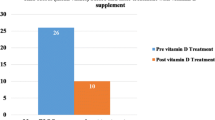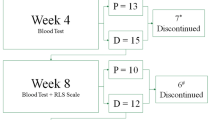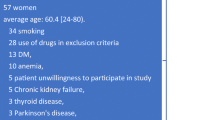Abstract
Purpose
To evaluate the effect of vitamin D on severity of restless legs syndrome in patients with idiopathic restless legs syndrome (RLS).
Methods
Patients with idiopathic RLS completed questionnaires including the International Restless Legs Severity Scale (IRLSS) and were evaluated for vitamin D deficiency. Patients with deficiency of vitamin D were treated with 50,000 units per week for 2 months. At the end of the 2 months, vitamin D levels were re-measured and disease severity was re-evaluated in patients who reached adequate vitamin D level. Subgroups of IRLSS questionnaire were also analyzed.
Results
Of 35 patients enrolled, 21 (60%) had vitamin D deficiency and received vitamin D therapy. In 2 patients, vitamin D levels did not rise to sufficient levels with supplementation and these 2 patients were excluded from analysis. The remaining 19 patients showed vitamin D levels increased from 13.2 ± 4.0 to 42.8 ± 9.6 ng/mL while IRLSS improved from 24.9 ± 5.1 to 21.1 ± 2.9 points (p <0.001). Selected subscores of the IRLSS were also improved including symptom severity (p <0.001), impact on sleep (p <0.001), symptom measures (p =0.002), and disease impact measures (p <0.001). There were trends toward improvement in subscores of frequency (p =0.11) and mood (p =0.051).
Conclusions
The findings suggest that vitamin D levels should be evaluated in patients with RLS and if vitamin D deficiency is revealed, consideration should be given to replacement therapy.u

Similar content being viewed by others
References
Allen RP, Picchietti D, Hening WA, Trenkwalder C, Walters AS, Montplaisi J, Restless Legs Syndrome Diagnosis and Epidemiology workshop at the National Institutes of Health, International Restless Legs Syndrome Study Group (2003) Restless leks syndrome: diagnostic criteria, special considerations, and epidemiology: a report from the restless legs syndrome diagnosisi and epidemiology workshop at the National Institues of Health. Sleep Med 4:101–119
Winkelman JW (2008) Considering the causes of RLS. Eur J Neurol 164(8–9):701–721
Allen RP, Picchietti DL, Garcia-Borreguare D et al (2014) Restless legs syndrome/Wills,ekbom disease diagnostic criteria: updated International Restless Legs Study Group (IRLSSG) consensus criteria ,history, rationale, description and significance. Sleep Med 15(8):860–873
Richard Allen, Dopamine and iron in the pathophysiology of restless legs syndrome (RLS) sleep medicine 5 (2004) 385–391
Trotti LM (2017) Restless legs syndrome and sleep-related movement disorders. Continuum (Minneap Minn) 23(4):1005–1016
Trenkwalder C, Allen R, HPgl B et al (2016) Restless legs syndrome associated with major diseases: a systematic review and new concept. Neurology 86(14):1336Y1343. https://doi.org/10.1212/WNL.0000000000002542
Rottach KG, Schaner BM, Kirch MH et al (2008) Restless legs syndrome as side effect of second generation antidepressants. J Psychiatr Res 43(1):70Y75. https://doi.org/10.1016/j.jpsychires.2008.02.006
Schurks M, Winter A, Berger K et al (2014) Migraine and restless legs syndrome: a systematic review. Cephalalgia 34(10):777Y794. https://doi.org/10.1177/0333102414537725
Chen PK, Fuh JL, Wang SJ (2016) Bidirectional triggering association between migraine and restless legs syndrome: a diary study. Cephalalgia 36(5):431Y436. https://doi.org/10.1177/0333102415596444
Holick MF, Krane SM, Potts JT. Calcium, phosphorus, and bone metabolism: calcium-regulation hormones. In: , Fauci AS, Braunwald
Bouillon R, Eelen G, Verlinden L, Mathieu C, Carmeliet G, Verstuyf A (2006) Vitamin D and cancer. J Steroid Biochem Mol Biol 102(1–5):156
Lange NE, Litonjua A, Hawrylowicz CM, Weiss S (2009) Vitamin D, the immune system and asthma. Expert Rev Clin Immunol 5(6):693
Liu PT, Stenger S, Li H, Wenzel L, Tan BH, Krutzik SR, Ochoa MT, Schauber J, Wu K, Meinken C, Kamen DL, Wagner M, Bals R, Steinmeyer A, Zügel U, Gallo RL, Eisenberg D, Hewison M, Hollis BW, Adams JS, Bloom BR, Modlin RL (2006) Toll-like receptor triggering of a vitamin D-mediated human antimicrobial response. Science 311(5768):1770
Li YC, Kong J, Wei M, Chen ZF, Liu SQ, Cao LP (2002) 1,25-Dihydroxyvitamin D(3) is a negative endocrine regulator of the renin-angiotensin system. J Clin Invest 110(2):229
Zipitis CS, Akobeng AK (2008) Vitamin D supplementation in early childhood and risk of type 1 diabetes: a systematic review and metaanalysis. Arch Dis Child 93(6):512
McGeer PL, Itagaki S, Boyes BE, McGeer EG (1988) Reactive microglia are positive for HLA-DR in the substantia nigra of PD and AD’ disease brain. Neurology 38:1285–12919
Heldenberg D, Tenenbaum G, Weisman Y (1992) Effect of iron on serum 25-hydroxyvitamin D and 24,25-dihydroxyvitamin D concentrations. Am J Clin Nutr 56(3):533–536
Fleet JC (2004) Rapid, membrane-initiated actions of 1,25 dihydroxyvitamin D: what are they and what do they mean? J Nutr 134:3215–3218
Veenstra TD, Prufer K, Koenigsberger C, Brimijoin SW, Grande JP, Kumar R (2005) 1,25-Dihydroxyvitamin D3 receptors in the central nervous system of the rat embryo. Brain Res 804:193–205
Baksi SN, Hughes MJ (1982) Chronic vitamin D deficiency in the weanling rat alters catecholamine metabolism in the cortex. Brain Res 242:387–390
Puchacz E, Stumpf WE, Stachowiak EK, Stachowiak MK (1996) Vitamin D increases expression of the tyrosine hydroxylase gene in adrenal medullary cells. Mol Brain Res 36:193–196
Fiszer U, Mix E, Fredrikson S, Kostulas V, Link H (1994) Parkinson’s disease and immunological abnormalities increase of HLA-DR expression on monocytes in cerebrospinal fluid and of CD45ro+ T cells in peripheral blood. Acta Neurol Scand 90:160–166
Derex L, Trouillas P (1997) Reversible Parkinsonism, hypophosphoremia, and hypocalcemia under vitamin D theraphy. Mov Disord 12(4):612–613
Gominak SC, Stumpf WE (2012) The world epidemic of sleep disorders is linked to vitamin D deficiency. Med Hypotheses 79:132e5
Jung YS, Chae CH, Kim YO et al (2017) The relationship between serum vitamin D levels and sleep quality in fixed day indoor field workers in the electronics manufacturing industry in Korea. Annals of Occupational and Environmental Medicine 29:25
Almeida OP, Hankey GJ, Yeap BB, Golledge J, Flicker L (2015) Vitamin D concanteration and its association with paat, current and future depression in older men. The Health in Men study Maturitas 81:36–41
Gordon B. Parkeri, Heather Brotchiei, Rebecca K. Garaham, Vitamin D and depression, J Affect Disord: PII: S0165–0327(16)30892–8
Oran M, Unsal C, Albayrak Y et al (2014) Possible association between vitamin D deficiency and restless legs syndrome. Neuropsych Dis Treat 10:953–958
Cakır T, Dogan G, Subası V, Filiz MB, Ulker N, Dogan SK, Toraman NF (2015) An evaluation of sleep quality and the prevalence of restless leg syndrome in vitamin D deficiency. Acta Neurol Belg (4):115, 623–117
Wali S, Shukr A, Boudal A, Alsaiari A, Krayem A (2015 May) The effect of vitamin D supplements on the severity of restless legs syndrome. Sleep Breath 19(2):579–583. https://doi.org/10.1007/s11325-014-1049-y
Wali SO, Abaalkhail B, Alhejaile F, Pandi-Perumal SR, Efficacy of vitamin D replacement theraphy in restless legs syndrome: a randomized control trial Sleep Breath 2019;23(2):595–601. doi: https://doi.org/10.1007/s11325-018-1751-2
Malabanan A, Veronikis IE, Holick MF (1998) Redefi ning vitamin D insufficiency. Lancet 351:805–806
Allen RP, Picchietti DL, Garcia-Borreguero D et al (2014) Restless legs syndrome/Willis-Ekbom disease diagnostic criteria: updated International Restless Legs Syndrome Study Group (IRLSSG) consensus criteria history, rationale, description, and significance. Sleep Med 15(8):860Y873. https://doi.org/10.1016/j.sleep.2014.03.025
The International Restless Legs Syndrome Study Group Validation of the International Restless Legs Syndrome Study Group rating scale for restless legs syndrome. Sleep Medicine 4(2003):121–132
Holick MF (2007) Vitamin D deficiency. N Engl J Med 357:266–281
Balaban H, Yıldız ÖK, Çil G, Şentürk İA, Erselcan T, Bolayır E, TopaktaŞ S (2012) Serum 25- hydroxyvitamin D levels in restless legs syndrome patients. Sleep Med 13(7):953–995
Wali S, Alsafadi S, Abaalkhail B, Ramadan I, Abulhamail B, Kousa M, Alshamrani R, Faruqui H, Faruqui A, Alama M, Hamed M (2018) The association between vitamin D level and restless legs syndrome: a population-based case–control study. J Clin Sleep Med 14:557–564
Sezgin G, Ozturk G, Turkal R, Caykara B (2019) Vitamin D levels of outpatşents admitted to a univeristy hospital in the Marmara region of turkey over 3 years. J Med Biochem 38:181–187
Nakhaee S, Ali Yaghoubi M, Zarban A, Amirabadizadeh A, Faghihi V, Yoosef Javadmoosavi S, Ataei H, Mehrpour O (2019) vitamin D deficiency and its associated risk factors in normal adult population of birjand, Iran. Clin Nutr ESPEN:113–117. https://doi.org/10.1016/j.clnesp.2019.04.002
Alogal F, Shihadeh Y, Boztepe H, Tanakol R, Yarman S, Azizlerli H, et al. Sunlight explosure and vitamin d deficiency in Turkish women J Endocrinol Invest 2000: 23:173–177
Author information
Authors and Affiliations
Corresponding author
Ethics declarations
The authors declare that they have no conflict of interest.
All procedures performed in studies involving human participants were in accordance with the ethical standards of the institutional and/or national research committee and with the 1964 Helsinki declaration and its later amendments or comparable ethical standards.
Informed consent was obtained from all individual participants included in the study.
Additional information
Comments
An increasing interest in many mechanisms of vitamin D potentially improves symptoms of a relatively rare sleep disorder but most importantly sleep itself. The awareness of treatment options without major side effects, besides conventional dopaminergic drugs, is definitely encouraging.
Rosalia Silvestri
Messina, Italy
Publisher’s note
Springer Nature remains neutral with regard to jurisdictional claims in published maps and institutional affiliations.
Rights and permissions
About this article
Cite this article
Tutuncu, M., Tutuncu, M. The effect of vitamin D on restless legs syndrome: prospective self-controlled case study. Sleep Breath 24, 1101–1106 (2020). https://doi.org/10.1007/s11325-019-01984-3
Received:
Revised:
Accepted:
Published:
Issue Date:
DOI: https://doi.org/10.1007/s11325-019-01984-3




